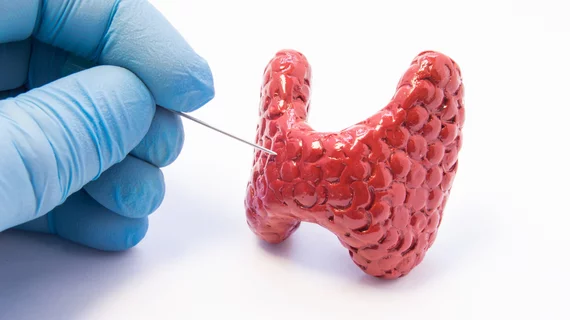Follow-up ultrasound for incidental thyroid nodules on CT not always cost-effective
Deploying ultrasound to follow up on incidentally detected thyroid nodules is not always financially sound, according to a new analysis published Wednesday in the American Journal of Roentgenology.
These findings are commonly spotted on chest CT, present in upward of 12% of patients. But they also carry a low risk of malignancy and often do not shorten patients’ life expectancy, researchers noted.
Wanting to determine the cost-effectiveness of sonographic follow up, scientists ran a simulation model incorporating 1 million patients with nodules measuring less than 40 mm and no suspicious features. Exploring various size cutoffs between 5-25 mm and an age range of 25-65 years old, investigators found this strategy didn’t always add up for certain patients.
“Our analysis showed that an age-based cutoff is more important than a size-based cutoff, with all cost-effective strategies recommending no follow-up for older patients,” Mark Hammer, MD, and Chung Yin Kong, PhD, with the Department of Radiology at Brigham and Women's Hospital and Icahn School of Medicine at Mount Sinai, respectively, wrote Oct. 20. “The importance of age-based cutoffs is likely attributable to the lower life expectancy of older patients, such that thyroid cancer, which is indolent and has long disease-related survival, is much less likely to cause the death of older patients, who are more likely to die of other causes,” they added later.
Their simulation model found that several strategies were cost-effective when using a willingness-to-pay threshold of $100,000 per quality-adjusted life year. But the most impactful approach was following up with ultrasound for patients under 60 years old with nodules larger than 10 mm, and no follow up for those over that age (with an incremental cost-effectiveness ratio of $50,000 per quality-adjusted life years).
Hammer et al. noted that current guidance from the American College of Radiology (all nodules larger than 15 mm in patients over 35) was not cost effective, likely because it resulted in treatment of additional older patients.
“Follow-up for thyroid cancer can be expensive, especially because a fraction of patients with benign nodules undergo surgery for diagnosis,” the authors advised. “As previously noted, treatment of incidental thyroid cancers is controversial, as many of these are unlikely to impact a patient’s life expectancy. Indeed, the recent increase in thyroid cancer diagnosis without an increase in associated deaths has been attributed to an increase in detection at imaging. Thus, the more sensitive strategies, such as the ACR recommendations, are not necessarily more cost-effective.”

